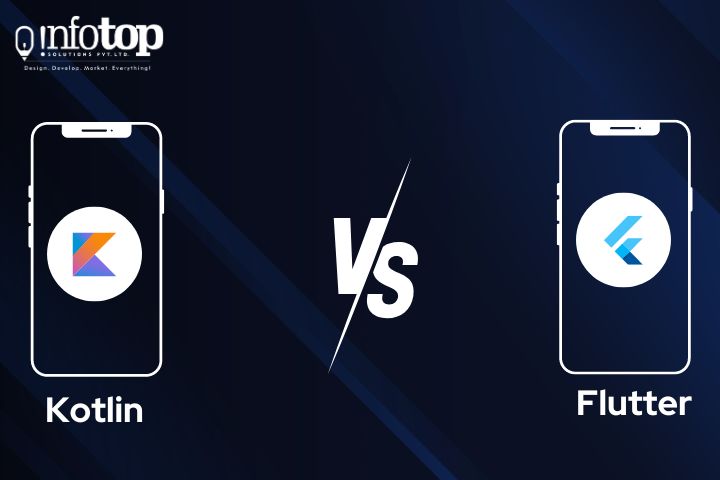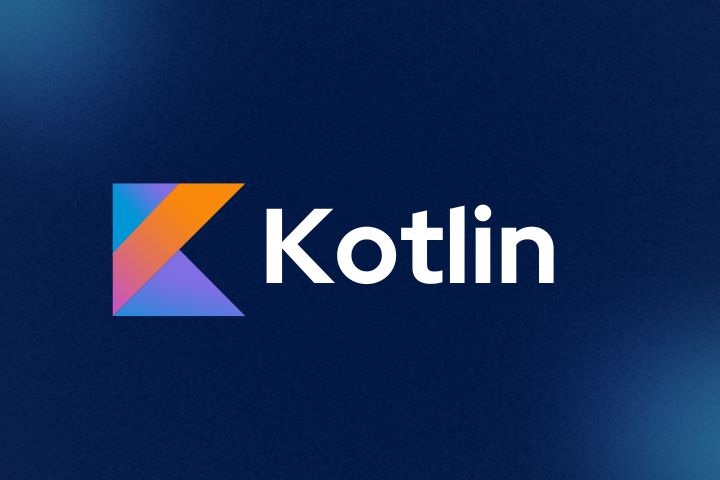
Flutter and Kotlin gained popularity in Android app development due to their robust, developer-friendly features, making them powerful and easy to use. When comparing Kotlin vs Flutter, it’s essential to understand their unique strengths and advantages for crafting high-quality Android applications.
To streamline your decision-making, we comprehensively compare Kotlin and Flutter for Android app development. Engaging with a trusted Android app development company ensures expert guidance for a well-informed decision aligned with your project goals and requirements.
First, let’s quickly examine both of these platforms.
Flutter

Google created Flutter using Dart to build natively compiled mobile, web, and desktop apps. It stands out as one of the most widely used frameworks today.
Flutter empowers you to construct apps for Android, iOS, Linux, Windows, Mac, Web, and more, all with a single codebase. It operates on an entirely open-source model and boasts a swiftly expanding community.
Pros
- Navigating and using Flutter is straightforward, and you can quickly grasp it thanks to its user-friendly documentation.
- The hot reload feature enables real-time viewing of backend changes in the front, eliminating the need to fill the entire app. This facilitates a much faster development pace, allowing for easy prototyping and tweaks.
- Through widgets, Flutter enables high customization, streamlining and expediting software development.
- It delivers high performance, closely rivalling that of native apps.
- Integrating with the real-time, cloud-hosted database Firebase simplifies data storage, management, and access.
- Creating cross-platform apps is effortless with Flutter, making it the preferred platform for many programmers.
- Flutter is open-source and available for use at no cost.
Cons
- Some other platforms may not support Flutter because it has yet to achieve widespread adoption, potentially excluding support from platforms like Jenkins, Travis, and others.
- Languages like Java, JavaScript, C#, and C might provide more educational resources than Java.
- Because it is a substantial framework, Flutter leads to larger app sizes than other frameworks, rendering it unsuitable for complex projects.
- Learning Dart is easy, but it has yet to be widely known among developers.
When to use Flutter
- Choose Flutter for launching your mobile app startup. Its robust features, cross-platform capabilities, and quick development cycles make it an ideal pick for turning your vision into a successful reality.
- In projects with frequent changes, the hot reload feature in Flutter quickly executes code changes. Collaborating with a proficient Flutter app development company enhances the utilization of this feature, ensuring seamless and efficient development cycles.
- When facing constraints in time, resources, and cost, Flutter provides easy setup, usability, and access to native-like features such as geolocation, camera, and more. This makes it an excellent choice for building MVPs and prototypes.
- For apps demanding high user engagement, like business and enterprise apps or online stores.
Kotlin

JetBrains developed Kotlin as a cross-platform general-purpose programming language. It seamlessly interoperates with Java and has been supported by Google for mobile app development on Android since May 2019.
Pros
- Kotlin presents a mature language and ecosystem, offering robust tools.
- Kotlin seamlessly integrates with Java, facilitating smooth migration and maintenance of apps using both languages. It also allows writing code without the necessity of migrating all existing code.
- Kotlin uses a syntax akin to Java, Scala, and Groovy, making it easily graspable for those acquainted with Java. This results in concise and readable code.
- The compiler in Kotlin ensures higher code safety by detecting errors, leading to fewer bugs, errors, and mistakes, thereby enhancing application reliability.
- Kotlin Multiplatform simplifies the development of cross-platform apps, allowing developers to share code and business logic across platforms such as iOS, Android, and the web. This accelerates development, minimizes errors and bugs, and enhances code maintainability.
- Kotlin scales and adapts flexibly.
Cons
- Even though the platform is free, developing apps in Kotlin can incur expenses.
- Learning Kotlin is necessary as it is a relatively new language.
- Kotlin has a limited number of available libraries.
- It compiles more slowly compared to Flutter.
When to use Kotlin
- When prioritizing Java compatibility, such as adding features to an existing Java-based app, developers can seamlessly make necessary changes using Kotlin, requiring minimal effort.
- Kotlin employs an intuitive syntax, making it easy to construct and maintain large and complex apps, particularly those requiring intricate code.
- In situations where extensive debugging is necessary, Kotlin’s compiler identifies and resolves crashes, automatically detecting and preventing the recurrence of bugs.
Conducting an in-depth comparison between Kotlin and Flutter
Let’s delve a bit deeper into some aspects of each of these platforms.
1. Popularity
While both platforms are gaining popularity rapidly, in the Kotlin versus Flutter comparison, Flutter emerges as the clear winner. Flutter is experiencing broader usage, and its adoption is outpacing Kotlin’s.
2. Learning curve
Kotlin boasts interoperability with Java and benefits from a straightforward syntax reminiscent of both Java and Swift. However, limited documentation and resources for Kotlin might pose a challenge. Therefore, it could be more accessible for those familiar with the Java ecosystem.
In contrast, developers opting for Flutter must acquire proficiency in the Dart programming language from the ground up. However, Flutter enjoys the advantage of extensive documentation, facilitating a straightforward learning process.
3. Performance
Flutter and Kotlin both excel in delivering outstanding performance.
Compiling directly to machine code, Flutter ensures remarkable speed for its apps. A diverse array of widgets enables achieving performance close to native.
Conversely, Kotlin compiles code in the format of the target platform. While both are close competitors in this category, this feature contributes to Kotlin’s superior performance.
4. Time to market
Setting up and configuring Flutter on various development environments, like Visual Studio Code and Android Studio, is straightforward. The hot reload feature lets developers instantly view real-time changes, expediting development.
Flutter likely achieves a shorter time to market due to these reasons. However, Kotlin also provides advantages such as concise syntax and code reuse, contributing to an accelerated time to market.
5. Frontend and backend capabilities
Renowned for its stunning UI, Flutter is highly user-friendly and provides an array of customization options through widgets. While its forte lies in the frontend, it also possesses robust backend capabilities, albeit requiring a bit more effort to enable them.
Conversely, as a general-purpose programming language, Kotlin provides developers with significant flexibility to construct and tailor their apps as required. It proves to be a suitable choice for developing large and complex applications, which might pose a slightly greater challenge with a framework like Flutter.
A qualified partner can assist you in making the correct decision
Choosing between Kotlin and Flutter for Android app development involves assessing project requirements. A reputable software development company in India can guide you through the decision-making process, ensuring optimal alignment with your goals, budget, and technical needs.
